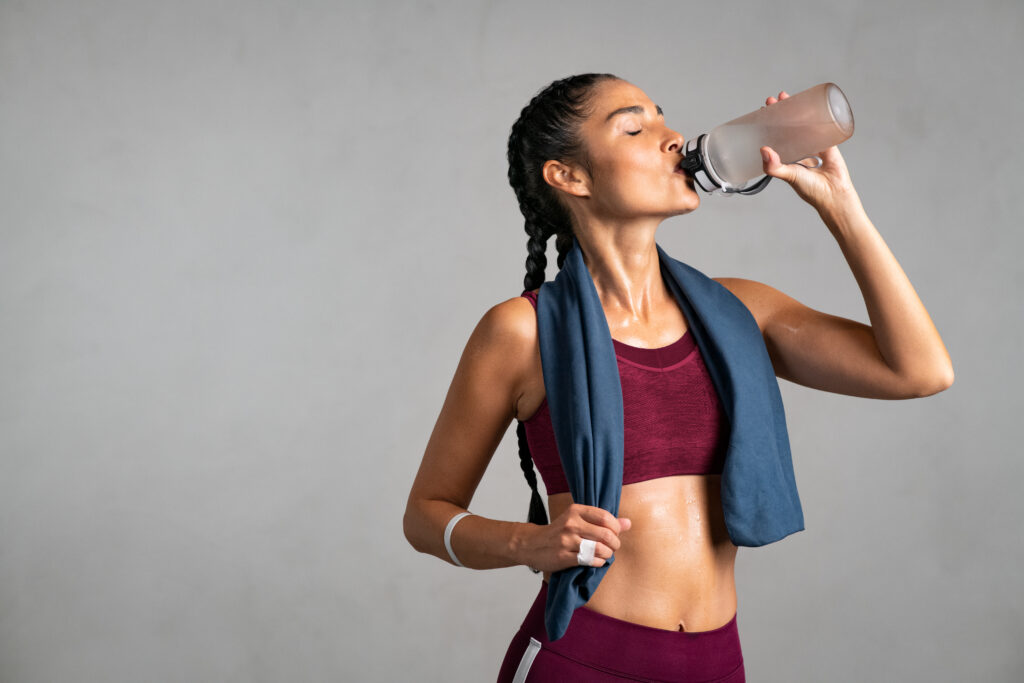Hydrate Your Young Athletes
During this Peak Summer Heat
-
The first days of formal practices in hot weather should be more for heat acclimatization than the conditioning of athletes, and practices in such conditions need planning to become longer and more strenuous over a gradual progression of time.
-
Schools also must consider moving practices to different locations or different times of day, or change practice plans to include different activities depending on the conditions. Furthermore, football practice rules allow for only helmets to be worn during the first two days, only shoulder pads to be added on the third and fourth days, and full pads to not be worn until the fifth day of team practice.
-
Student-athletes should make sure to hydrate all day long – beginning before practice, continuing during and also after practice is done. Water and properly-formulated sports drinks are the best choices for hydration.
Prevention Tips
- Drink plenty of fluids. Be sure your athletes increase their fluid intake, regardless of activity level during hot or humid weather.
- Choose lightweight, light-colored, loose-fitting clothing.
- If you must be outdoors, try to limit your practices to morning and evening hours. Try to rest often in shady areas.
- If your athletes are not accustomed to exercising in a hot environment, start slowly and pick up the pace gradually.
- Allow your athletes to adjust to the environment. An athlete’s tolerance for heat will improve over time, if you limit their physical activity until they become accustomed to the heat.
FAQs: Dehydration
Thirst, muscle cramps, weakness, decreased attention, decreased performance, nausea, fatigue, headache, lightheadedness and dark color urine.
You should drink regularly so that your body is accustomed to being hydrated. Before activity you should drink about 20oz or 2 ½ cups of water or sports drink. During activity you should drink water or sports drink at least 3-4 times per hour or every 10-15 minutes. After activity you should drink 20oz or 2 ½ cups of water or sports drink per every pound lost.
As little as 2% loss of body fluid can have detrimental effects on the body such as faster heartbeat, impaired decision-making ability and increased body temperature. Weight loss during activity is water loss, NOT fat loss.
If your urine looks pale like lemonade, it’s a good sign of hydration. If it’s dark like apple juice, it’s a sign of dehydration.
Water, sports drinks, juice, milk, and popsicles are all acceptable sources. One may work better or worse for one athlete than another. Find what works for you and stay hydrated. By the time you feel thirsty, your body is already dehydrated.
Again this may be a preference per each individual athlete. Typically for workouts that last less than 90 minutes, water is the better choice. For workouts lasting more than 90 minutes, a sports drink may be helpful to replace lost sodium and other nutrients.
General Guidelines for Heat Illness
Dehydration
Dehydration occurs when the body loses too much fluid. Dehydration impairs athletic performance whenever body fluid level falls below 98% of normal. The primary cause of dehydration is sweat loss, an essential body process which facilitates the release of body heat into the environment. When athletes don’t replace what they lose in sweat, the physiological function of the body’s heat management system is compromised, placing both the athletes’ performance and physical well-being at risk.
Signs & Symptoms
- Thirst
- Fatigue
- Irritability
- Nausea
- Vomiting
- Muscle Cramps
- Loss of Performance
Actions to Take
- Re-hydrate
- Stop activity
Heat Exhaustion
This is a serious form of heat illness, but not as severe as heat stroke.
Signs & Symptoms
- Dizziness
- Headache
- Nausea
- Vomiting
- Weakness
- Rapid Pulse
- Cold, clammy skin
Actions to Take
- Replace fluids (re-hydration is critical)
- Rest in a cool, shaded area until all symptoms have passed.
- If dizziness continues, lie the athlete down, elevate their legs, and seek medical attention.
Heat Stroke
The most severe heat-related illness, heat stroke can permanently impair or kill an untreated athlete. Symptoms are similar to heat exhaustion, plus hyperthermia (high body temperature) whereby the core body temperature can be higher than 105.8 degrees. This can lead to conditions such as convulsions, heart attacks, coma, stroke, liver and kidney damage, or blood clots in the lung. If an athlete is not immediately immersed in ice water, he/she can die or suffer permanent physical damage.
Signs & Symptoms
* Medical Emergency
- Irrational Behavior
- Drowsiness
- Nausea
- Hot, dry skin
- Confused or disoriented
- Dangerously high temperature
Actions to Take
- Get out of sun and seek immediate medial attention. This is an emergency, call 911.
- Cool immediately using ice baths, ice bags, or whatever is available for you to use.
* REMEMBER: Athletes can still be experiencing heat stroke even if most symptoms are absent. Seek medical attention immediately at the first sign of serious or unusual symptoms.
Source: Michigan High School Athletic Association

